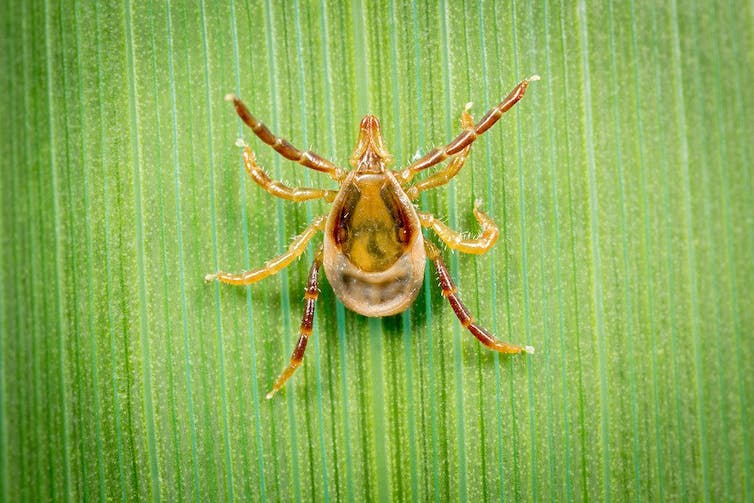Ticks in Australia are a health risk. Reactions to their bites can be severe; they can cause life-threatening paralysis and allergies and transmit disease-causing pathogens. But it is the debate about Lyme disease and its presence in Australia that has occupied media headlines and the minds of scientists and health professionals for more than three decades.
What is Lyme disease?
Lyme disease (also known as Lyme borreliosis) is caused by the bacteria Borrelia burgdorferi sensu lato. Cases are reported from North America, Europe and temperate regions of northern Asia.
Symptoms associated may include a distinctive “bullseye”-shaped rash, followed by flu-like symptoms (such as fever, headache, sore muscle and joints, fatigue), various neurological manifestations and arthritis. Some forms in Europe can even cause a dermatological condition known as acrodermatitis chronica atrophicans, which causes swelling and discolouration of the hands or feet.
Lyme disease is diagnosed based on symptoms, a history of exposure to ticks, and validated laboratory tests. If diagnosed and treated early with appropriate antibiotics, infected individuals have a quick recovery.
Ticks spread the bacteria. The ticks primarily responsible are those commonly known as the “black legged” ticks. The ticks acquire the bacteria through biting small mammals, particularly the mice that are the natural reservoirs of the pathogen. When the tick then bites people, the bacteria are transmitted via the tick saliva.
Is Lyme disease in Australia?
The presence in Australia of Lyme disease, or a “Lyme-like” illness, is highly debatable. It has long been a contentious issue fuelled by emotional stories of patients suffering illness following exposure to ticks. However, there remains a lack of any compelling scientific evidence that the pathogen that causes Lyme disease is present in Australia.
The ticks known to transmit Borrelia burgdorferi overseas are not found in Australia, but we certainly have plenty of local ticks.
The Australian paralysis tick, Ixodes holocyclus, is generally thought to pose the greatest local health risk. The tick bites people, causing allergic reactions ranging from a mild itching with localised swelling, to a life-threatening anaphylactic condition and the development of a mammalian meat allergy. Laboratory studies show this tick cannot transmit Borrelia burgdorferi.
Could another tick species be involved?
Since the 1990s, scientists have searched for Borrelia burgdorferi in local ticks and wildlife but the bacteria have never been definitively detected. Perhaps the tick-borne pathogen responsible for the reported cases of “Lyme-like” illness is yet to be found. Or it simply may not exist.

The Australian paralysis tick, Ixodes holocyclus Stephen Doggett (NSW Health Pathology)
Reviewing evidence and experience
In 2013, the Chief Medical Officer of Australia established the Clinical Advisory Committee on Lyme Disease. The terms of reference broadly covered the examination of the evidence of Lyme disease in Australia. It sought to identify research requirements as well as review the appropriateness of the associated diagnostic testing and treatment of human cases.
The committee was convened for one year. In that time no conclusive evidence was provided that established whether or not a tick-borne pathogen was responsible for suspected Lyme disease cases in Australia.
A recently published major review of 25 years of research studied more than 500 cases of Lyme-like illness reported in the scientific literature. The authors conclude that no study to date definitively identifies Borrelia burgdorferi as responsible for locally acquired Lyme disease, or that any of the human cases could be definitely called Lyme disease.
It is impossible to completely discount the possibility that an unidentified tick-borne pathogen is responsible for suspected illness. Research continues and emerging technologies will provide opportunities to discover and better understand the microorganisms associated with local ticks.
Without conclusive evidence, debate continues.
A Senate inquiry, “Growing evidence of an emerging tick-borne disease that causes a Lyme-like illness for many Australian patients”, has recently begun. With hundreds of submissions received, hearings are being held across the country.
A hurdle may present itself should a double dissolution election be called and the inquiry halted. It must be hoped that the inquiry, supported by the new Senate, will continue following the election. While its fate is uncertain, even if it were to continue, it is unlikely to resolve the issue.
Irrespective of the eventual outcome of the Senate inquiry, or any findings from current or future research, health authorities will continue to warn the community to avoid ticks.
If you do find a tick attached, make sure you follow the recommendations provided by the Australasian Society of Clinical Immunology and Allergy (ASCIA) to “freeze not squeeze”. Before removing the tick, use an aerosol “freezing” spray (the type normally used for wart treatments) to rapidly kill the tick. That way you can minimise any potentially serious reactions.![]()
Cameron Webb, Clinical Lecturer and Principal Hospital Scientist, University of Sydney
This article is republished from The Conversation under a Creative Commons license. Read the original article.


